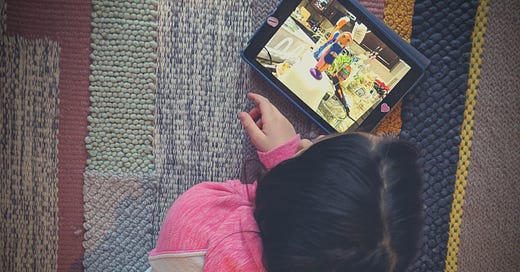Ever since the onset of COVID-19, 2020 has felt like a year of seismic changes—especially for parents. Life feels undeniably different, but when you take inventory of the things that have "changed," you start to realize that many of these changes were already underway before the pandemic. All COVID-19 did was speed up the cultural shifts that were already underway. Take screen time for example: when families were suddenly locked down together with no offices or schools to go to, technology use skyrocketed. Devices were no longer the enemy, and parents started to rely on screen time to help their kids connect to loved ones, explore their creativity and cultivate new interests and passions. Anxiety over total screen time suddenly seemed like yesterday's concern, and many experts and parents alike began to judge tech based on what kinds of activities their kids were doing on their devices.
But again, this isn't a totally new shift. We had been trending in this direction for a while—and then the pandemic just gave us a powerful shove over the edge. Many technology experts have been advocating for a more nuanced assessment of screen time for a while, and it's something I also explored at length in my book Screen Captured, which was published in a pre-pandemic world.
Screen Captured was the ultimate result of the research I did while establishing my kid-tech company, Kinzoo. The more I read on the topic, the more I started to think critically about the type of screen time. I became convinced that we need to worry less about duration and take a closer look at what our children are doing while they're on their devices. For our family, navigating the issue of screen time became easier when I started distinguishing between “screen time” and “screen captured.” The latter is the term I use to describe what happens when we use technology that’s intentionally designed to manipulate and influence our behavior. Think: manipulative algorithms, social validation or apps that feature arbitrary goals or streaks. That kind of tech is meant to pull at our synapses and keep us engaged for as long as possible—and our kids are especially vulnerable.
By contrast, certain tech activities are net-positive for kids: things that connect kids with family and friends, encourage creativity and ignite new passions. As a parent, I'm more than happy to let my daughter enjoy technology if she's gaining something from it. The way I see it, she's better off with three hours of skill-building time online than 10 minutes of screen capture.
The pandemic has brought so many challenges to parents this year, but if there's one positive change to come out of it, hopefully we can finally retire the screen time anxiety—and start focusing on quality over quantity.
A deeper dive
Here are a few helpful resources in case you want to really dig into today's topic:
Tech use, on the whole, has increased for kids in lots of different age groups. You might be wondering if this increase is here to stay. Well, according to a bunch of different surveys, it probably is.
Now maybe you're feeling some residual "screen time anxiety" leftover from our pre-pandemic conditioning. You're definitely not alone. Here are some insights from tech expert Jordan Shapiro—who shares a few of the reasons he's not worried about his kids' increased screen time.
TL;DR
Too long; didn't read. It shouldn't be a full-time job to keep up on industry news, so here is a mercifully quick summary of some other notable developments:
Animal Jam, a popular online game for kids, recently disclosed that a major data breach occurred sometime in mid-October, exposing roughly 46 million user accounts. Compromised information includes emails, usernames, IP addresses, dates of birth, physical addresses, parent names and encrypted passwords. Animal Jam promptly released a thorough statement about the breach on its website. All users will be required to change their passwords as a precaution, and the company offered some tips to help people protect themselves at the end of the post.
One of the biggest online safety threats for kids is actually their own digital footprint and it certainly doesn't help to be lulled into a false sense of security with "disappearing" messages. Facebook recently introduced "Vanish Mode" to messenger and Instagram on mobile, allowing users to send messages that disappear. Much like Snapchat, users will be notified if the recipient takes a screenshot of their message—which unfortunately doesn't do a whole lot of good if the content was sensitive. Larry Magid, CEO of ConnectSafely has this advice: "When it comes to all digital media—vanishing or not—parents should remind their kids that there is never a guarantee that secrets will remain secret."
And lastly
Here are a few more pieces of original writing from me and my team—just in case you're keen for more:
If you want to learn more about how to avoid becoming screen captured, check out this helpful resource on the Kinzoo blog!
And for more tips on how to talk to your kids about their digital footprint, check out this advice from online safety expert, The White Hatter.




